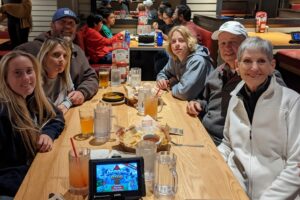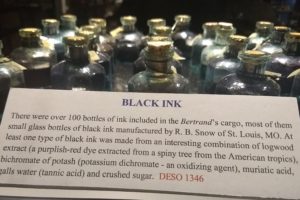A part of camping that Barney and I have looked forward to is getting to sit outside with neighbors, getting to know them and learn about life from their point of view. Since most of our camping has been in cold and colder weather, our conversations with others has been pretty brief. Yesterday the tide changed.
As Barney was working around the RV and starting to do a workout, he started chatting with the couple next to us who were from the area and had lots of suggestions for us. I joined them, and we had a wonderful conversation. I wanted to take a picture of Jim and Karen, but they didn’t want that so you won’t get to see this couple. (Possibly in Witness Protection? They said no.)
Anyway, they suggested we take the ferry across the inlet to Bolivar Island. The state of Texas provides this ferry for free, and ferries are constantly going back and forth. Bolivar Island is the southern way to drive to Beaumont and Port Arthur. Up to 70 vehicles can be carried across, 3 rows on each side of the ferry, and 500 passengers. Both ends of the ferry have pilot houses so the ferry never has to turn around. The trip takes about 15 minutes, and we could either stay in the truck with the engine off or walk outside and see the ships in the bay. Because of the recent fire in the Houston ports, ships are waiting in the bay until they can come in and load/upload.
So let’s talk about geography a little before we go on. Galveston is on Galveston Island, and it can be reached by a bridge. Galveston is south of Houston about 30 minutes. The inlet between Galveston Island and Bolivar Island is the only entrance to Galveston Bay from the Gulf of Mexico; Galveston Bay opens up to the port at Houston so is really important and very busy.
Our new friends told us about a restaurant right on the water, so we decided to go there for lunch and explore the area.
As we were driving off the ferry, we saw an historical marker and turned off the road to start reading about the woman who’s called the Mother of Texas since her daughter was one of the first pioneers born in the area.

We also were intrigued by her involvement with Stephen F. Austin’s first colony in southern Texas. We learned about this colony when we were at the Texas Ranger Museum in Waco. These pioneers were the buffer between the Mexicans and the Indians, and Austin hired men to protect them. These men were the first Texas Rangers!
More information about the area:

Fort Travis was established at this location, and was a military presence in the area since the mid-1800s since the location was right at the inlet on the Gulf of Mexico.


Earthen works called batteries are here showing how the area has been used militarily because of its strategic location. First in 1899, they had guns that would “disappear” after being fired so the soldiers could stay safe; they were the most advanced of their day. All were built out of reinforced concrete.


looking into the battery 
backside of the battery from the seawall
This is the largest structure in the grassy area and was built after WWI.

aerial view of Kimble battery

Newest battery built during WWII. It never received its cannons and was decommissioned without ever being used.


Our friends at our campsite told us about houses built on this island. After hurricane Ike in 2008 when the waters came up so high. new houses began to be built on taller stilts. The idea is that the height of the stilts is equal to the depth of the supports underground. Here’s one new house that has a great view of the Gulf.

Even the local elementary/middle school is on stilts with a 9′ 4″ height and parking underneath.
Finally we made it to Stingaree Restaurant & Marina right on the Intracoastal Waterway.
We’ve known about this waterway since Barney and the boys lived on it in North Carolina when he was in the service, and Brian, our middle son, lives close to it on the Atlantic side of southern Florida. But we didn’t know it extended into Texas! It actually runs 3000 miles from Boston, around the southern tip of Florida, and then follows the Gulf Coast to Brownsville, Texas. Fascinating.
Some barges came by as we were eating on their way to and from the Beaumont/Port Arthur ports. This part of the Intracoastal has more commercial business on it that we’ve been used to but is also much wider than what we’ve known on the East Coast. It can handle such long barges.
Just as we were finishing our wonderful lunch, our friends from the campsite stopped by on their way home, and we got to chat with them a little more. Love these “chance” encounters.
We’ve loved our time in Galveston and have felt so welcomed. Our friends told us that the city has daily activities during the winter for their Winter Texan visitors. We may have to come back during this time.

On to Corpus Christi tomorrow!










